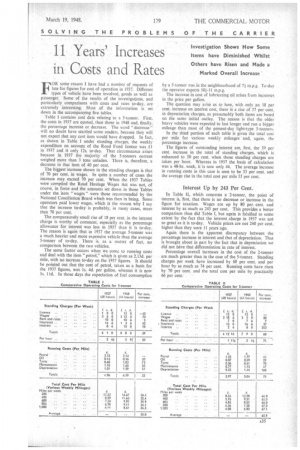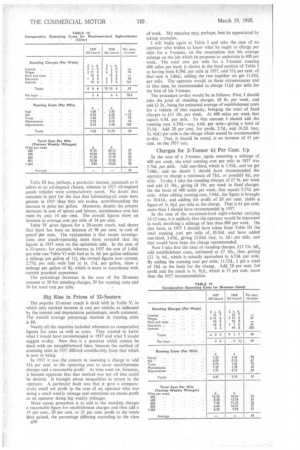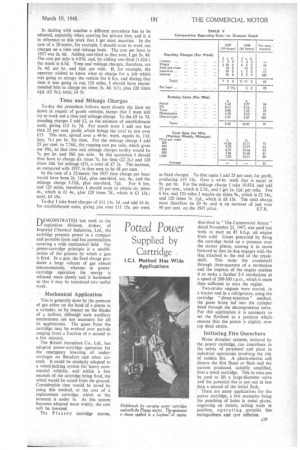11 Years' Increases in Costs and Rates
Page 45

Page 46

Page 49

If you've noticed an error in this article please click here to report it so we can fix it.
Investigation Shows How Some Items have Diminished Whilst Others have Risen and Made a Marked Overall Increase
FOR some reason I have had a number of requests of late for figures for cost of operation in 1937. Different types of vehicle have been involved, goods as well as passenger. Some of the results of the investigations, and particularly comparisons with costs and rates to-day, are extremely interesting. Most of the information is set down in the accompanying five tables.
• Table I contains cost data relating to a 5-tonner. First, the costs in 1937 are quoted, then those in 1948 and, finally, the percentage increase or decrease. The word " decrease " will no doubt have startled some readers, because they will not expect that any cost item would have dropped. In fact, as shown in Table I under standing charges, the weekly• expenditure on account of the Road Fund licence was £ I in 1937 and it only 12s. to-day. That circumstance arises because in 1937 the majority of the 5-tonners current weighed more than 3 tons unladen. There is, therefore, a decrease in that item of 40 per cent.
The big.gest increase shown in the standing charges is that of 70 per cent, in wages. In quite a number of cases the increase may exceed 70 per cent. When the 1937 Tables were compiled the Road Haulage Wages Act was not, of course, in force and the amounts set down in those Tables under the item "wages" were those recommended by the National Conciliation Board which was then in being. Some operators paid lower wages, which it the reason why I say that the increase to-day is probably, in many cases, more than 70 per cent.
The comparatively small rise of 18 per cent, in the interest charge is worthy of comment, especially as the percentage allowance for interest was less in 1937 than it is to-day. The reason is again that in 1937 the average 5-tonner was a much heavier and more expensive vehicle than the average 5-tonner of to-day. There is, as a matter of fact, no comparison between the two vehicles.
The same factor occurs when we come to running costs and deal with the item "petrol," which is given as 2.13d. per mile, with no increase to-day on the 1937 figures. It should be pointed out that the cost of petrol, taken as a basis for the 1937 figures, was Is. 4d. per gallon, whereas it is now 1s. lid. In those days the expectation of fuel consumption by a 5-tonner was in the neighbourhood of 7i m.p.g. To-day the operator expects 104-II m.p.g.
The increase in cost of lubricating oil arises from increases in the price per gallon.
The question may arise as to how, with only an 18 per cent. increase on inteiest cost, there is a rise of 57 per cent. in depreciation charges, as presumably both items are based on the same initial outlay. The reason is that the older heavy vehicles were expected to last longer and run a bigger mileage than most of the present-day light-type 5-tonners.
In the third portion of each table is given the total cost per mile for various weekly mileages and, again, the percentage increase.
The figures of outstanding interest are, first, the 39 per cent. increase in the total of standing charges, which is enhanced to 50 per cent. when those standing charges are taken per hour. Whereas in 1937 the basis of calculation was a 48-hr. week, it is now only 44. The average increase in running costs in this case is seen to be 33 per cent, and the average rise in the total cost per mile 35 per cent.
Interest Up by 243 Per Cent.
In Table II,, which concerns a 2-tonner, the point of interest is, first, that there is no decrease or increase in the figure for taxation. Wages are up by 80 per cent. and interest by as much as 243 per cent. This provides a better comparison than did Table I, but again is falsified to some extent by the fact that• the interest charge in 1937 was not so great as it is to-day. Vehicle prices are not 240 per cent. higher than they were II years ago.
Again there is the apparent discrepancy between the percentage increase in interest and that of depreciation. That is brought about in part by the fact that in depreciation we did not hhve that differentiation in rate of interest.
Percentage overall increases in the cost of the 2-tonner are much greater than in the case of the 5-tonner. Standing charges per week, have increased by 60 per cent, and per hour by as much as 74 per cent. Running costs have risen by 70 per cent. and the total cost per mile by practically 66 per cent. Table III has, perhaps, a particular interest, inasmuch as it refers to an oil-engined chassis, whereas in 1937 oil-engined goods vehicles were -comparatively novel. No doubt that accounts in part for the fact that lubricating-oil costs were greater in 1.937 than they are to-day, notwithstanding the increase in price per gallon. Moreover, despite the present increases in cost of spares and labour, maintenance cost has risen by only 14 per cent. The overall figures show an increase, in average cost per mile of 54 per cent.
Table IV gives figuresfor a 20-seater coach, and shows that there has been an increase of 98 per cent. in cost of petrol per mile. The explanation is that recent investigations into coach-operating -costs have revealed that the figures in 1937 were on the optimistic side. In the case of a 32-seater, for example, whereas in 1937 the cost of 1.40d. per mile (see Table V) with fuel at -1s. 4d. per gallon indicates a mileage per. gallon of 111, the revised figures now current, 2.77d. per mile-: with fuel at is. 11d, per gallon, show a mileage per gallon of 81, which is more in accordance with current practical experience.
The percentage increases in the case of the 20-seater amount to 50 for standing charges, 59 for running costs and 56 for total cost per mile.
Big Rise in Prices of 32-Seaters
The popular 32-seater coach is dealt with in Table V, in which only marked increase in cost per vehicle, as indicated by the interest and depreciation percentages, needs comment. The overall average percentage increase in running costs is 84.
Nearly all the inquiries included references to comparative figures for rates as well as costs. They wanted to know what I would have recommended in 1937 and what I would suggest to-day. Now that is a question which cannot be dealt with onstraightforward lines, because the method of assessing rates in 1937 differed considerably from that which is now in being.
In 1937 it was the custom in assessing a charge to add 33* per cent, to the operating cost to cover establishment charges and a reasonable profit.'" As time went on, however, it became apparent that that method was not all that could be desired. It brought about inequalities in return to the operator. A particular -fault was that it gave a comparatively small net profit in the case of an operator who was doing a small weekly mileage and sometimes an excess profit to an operator doing big weekly mileages.
More recent procedure is to add to the standing charges a reasonable figure for establishment charges and then add a 15 per cent., 20 per cent. or 25 per cent, profit to the totals thus gained, the percentage differing according to the class A36 of work. My meaning may, perhaps, best be appreciated by taking examples.
I will begin again at Table I and take the case of an operator who wishes to know what he Ought to charge per mile for a 5-tonner, on the assumption that his average mileage on the job which he proposes to undertake is 400 per week. The total cost per mile for a 5-tonner running 400 miles per week is shown in the third portion of Table I as having been 8.59d. per mile in 1937, and 331 per cent. of that sum is 2.86d.; adding the two together we get 11.45d. per mile. The operator would, in those circumstances and at that time, be recommended to charge 111d. per mile for the hire of his 5-tonner.
The procedure to-day would be as follows: First, I should take the ,total of standing charges, £8 8s. per week, and add £3 2s., being the estimated average of establishment costs for a vehicle of that capacity, bringing the total of fixed charges to £11 10s. per week. At 400 miles per week that equals 6.9d. per mile. To that amount I should add the running cost, 6 59c1.-say, 6.6d. per mile-giving a total of 13.5d. Add 20 per cent. for profit. 2.7d., and 16.2d. (say, Is. 4W.) per mile is the charge which would be recommended to-day. That, it should be noted, is an increase of 41 per cent. on the 1937 rate.
Charges for 2-Tonner 61 Per Cent. Up
In the case of a 2-tonner, again assuming a mileage of 400 per week, the total running cost per mile in 1937 was 5.76d. per mile. Add one-third, which is 1.92d., and we get 7.68d., and no doubt I should have recommended the operator to charge a minimum of 71(1., or possibiji 8d., per mile. To-day I take the standing charges of £7 9s. per week and add El 10s., giving £8 19s. per week as fixed charges. On the basis of 400 miles per week, that equals 5.37d. per mile. After adding running cost, 5.04d., the figure is brought to 10.41d., and adding the profit of 20 per cent. yields a figure of Is. 01d. per mile as the charge. That is 61 per cent. more than I should have recommended in 1937.
In the case of the maximum-load eight-wheeler carrying 14-15 tons, it is unlikely that the operator would be interested in work involving a mileage of less than 800 per week. On that basis, in 1937 I should have taken from Table 111 the total running cost per mile of. 10.36d. and have added one-third, 3.45d., giving 13.81d. (say, Is. 2d.) per mile, and that would have been the charge recommended.
Now I take first the total of rtanding charges. £13 13s. 6d., add establishment costs, estimated at £7 10s., thus getting £21 3s. 6d., which is actually equivalent to 6.53d. per mile. By adding the running cost per mile, 11.72d., I get a total of 18d. as the basis for the charge. Add 20 per cent. foe profit and the result is Is. 91d., which is 53 per cent. more than the 1937 recommendation. In dealing with coaches a different procedure has to be adopted, especially when catering for private hire, and it is in reference to this work that I get most inquiries. In the case of a 20-seater, for example, I should want to work out charges on a time and mileage basis. The cost per hour in 1937 was 2s. 6d. Adding one-third to that sum, I get 3s. 4d. The cost per mile is 4.87d, and, by adding one-third (1.62d.), the result is 6.5d. Time and mileage charges, therefore, are 3s. 4d. per hr. and 6id. per mile. if, for example, the operator wished to know what to charge for a job which was going to occupy the vehicle for 6 hrs, and during that time it Was going to run 120 miles, I should have recommended him to charge six times 3s. 4d. (£1), plus 120 times 61d. (£3 5s.); total, £4 5s.
Time and Mileage Charges.
To-day the procedure follows more closely the lines set down in respect of goods vehicles, except that I must still try to work out a time and mileage charge. To the £9 Is. 7d. standing charges I add £3, as the estimate of establishment costs, giving £12 Is. 7d. For coach work I. add not less than 25 per cent, profit, which brings the total to just over £15. This sum, spread over a 44-hr. week, equals 6s. lid. (say, 7s.) per hr. for time. For the mileage charge I add 25 per cent. to 7.74d., the running cost per mile, which gives me 10d., so that time and mileage charges to-day would be 78. per hr. and 10d. per mile. In this quotation 1 should thus have to charge six times 7s. for time (f2 25.) and 120 times 10d. for mileage (£5), a total of £7 2s. The increase, as compared with 1937, is thus seen to be 68 per cent. -) In the case of a 32-seater, the 1937 time charge per hour would have been 2s. 11 id., plus one-third, say, 4s., and the mileage charge 5.52d., plus one-third, 7id. For 6 hrs. and 120 miles, therefore, I should want to obtain six times 4s.,which is £1 45., plus 120 times 7d., which is £3 15s.; total, £4 19s.
To-day I take fixed charges of £11 1 Is. 3d. and add £4 4s. for establishment-costs, giving just over £15 15s, per week as fixed charges. To that again I add 25 per cent. for profit, producing £19 15s. Over a 44-hr. week that is equal to 9s. per hr. For the mileage charge I take 10.83d. and add 25 per cent., which is 2.7d., and I get Is. lid. per mile. For 6 hrs. and 120 miles I require six times 9s., which is £2 I4s., and 120 times Is. lid., which is £6 15s. The total charge must therefore be £9 9s and is an increase of just over 90 per cent. on the 1937 price. S.T.R.












































































